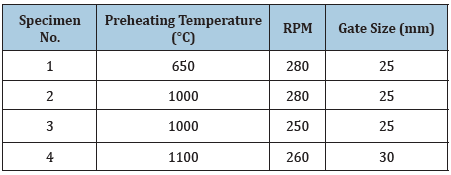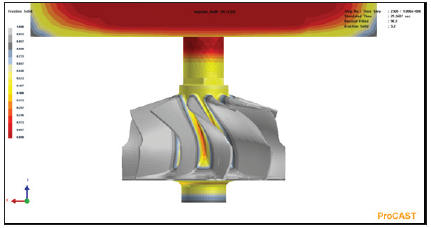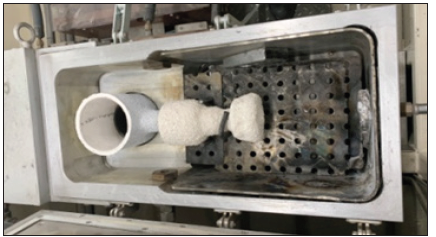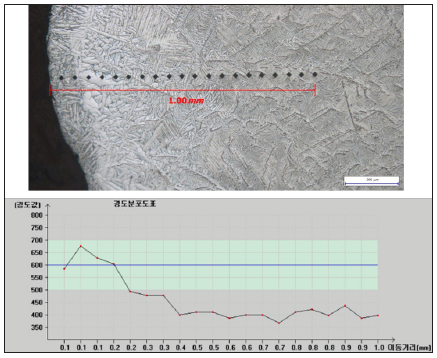- Submissions

Full Text
Novel Research in Sciences
Effects of Vacuum Centrifugal Casting in manufacturing Turbo Charger Turbine Wheels of Ti-48Al-2Cr-2Nb
Sung Joon Pak1 and Hyeongkyu Ju2*
1Kitech, Korea
2Department of Nano Physics, Korea
*Corresponding author: Hyeongkyu Ju, Department of Nano Physics, Korea
Submission: November 04, 2020;Published: January 25, 2021
.jpg)
Volume5 Issue4January, 2021
Abstract
The effects of vacuum centrifugal casting in manufacturing 80mm diameter Ti-48Al-2Cr-2Nb turbocharger turbine wheel have been studied using centrifugal caster and surface analysis technique. Based on the good compatibility to high temperature environment, Ti-48Al-2Cr-2Nb is used for high speed materials of military equipment. Recently, centrifugal casting method is noticed to manufacture cost effective high temperature materials. In this paper, the effects of the vacuum centrifugal casting and optimum conditions are discussed based on surface analysis. According to the results, the diameter of the gate needs to be 30mm and RPM should be 260. The mode of vacuum centrifugal casting is deeply related to the gate size, RPM, and cooling method. Therefore, it is considered that pouring temperature, preheating temperature, RPM, and cooling method play important roles in manufacturing of Ti-48Al-2Cr- 2Nb turbocharger turbine wheel. In this study, by using a ceramic mold in which Ti powder is mixed with Al2O3, it was confirmed that the alpha-case layer was formed in the hardness elevation area in the area less than 50μm on the surface.
Keywords: Vacuum centrifugal casting; Ti-48Al-2Cr-2Nb;Turbocharger;Turbine wheel
Introduction
Ti-alloy has high specific strength and excellent mechanical properties. Many people from 40-50 years ago to the present have been applied Ti-alloy to the specific field, and its usage and application fields continue to increase [1,2]. As a representative composition among Tialloys, Ti-6Al-4V (6 wt% Al, 4 wt% V) alloy, the mechanical properties are very good, so it accounts for more than 60% of the applied Ti-alloys. Ti-6Al-4V alloy is α + β among the general classification of Ti-alloys. It is an alloy between the characteristics of α-type Ti-alloy and β-type Ti-alloy. It is useful because it can obtain microstructure and mechanical properties of very high value [3-5]. As another alloy system, γ-TiAl alloy has a specific gravity of only half compared to the nickel-based alloy developed as a representative heat-resistant alloy, and up to 1700K, which is near the melting point. TiAl alloy is a lightweight alloy that maintains the regular structure of intermetallic compounds and has high specific strength, excellent oxidation resistance and high temperature creep characteristics. Therefore, until now, based on these excellent properties, studies have been conducted to apply TiAl alloy as engine blades for aircraft in order to dramatically improve the performance of aircraft engines used in extreme environments [6-8]. Particularly, TiAl alloy is oxidized at 1100K to brittle fracture at the same level as ceramics and abnormal fracture under high temperature dynamic loads. It is a reality that it is not used as a turbine blade in the combustion part of the latter part of the engine, but is used only as a blade in the suction part of the front end of the engine, which has relatively low operating temperature and pressure [9,10]. Particularly, the TiAl/Ti3Al twophase alloy having a microstructure such as a layered structure and a composite structure is attracting great attention for its practical use. Recently, in order to reduce the weight of parts requiring excellent high-temperature properties, many studies have been attempted to improve the insufficient room temperature ductility of the fully layered TiAl/Ti3Al two-phase alloy with excellent high-temperature properties, and a one-way solidification method was introduced to the layer boundary direction. Research is actively underway to control in the direction of softening [11]. In addition, the global automobile market is showing high interest in the development and application of new technologies for fuel economy competition and emission reduction. In the case of gasoline cars, the engine downsizing through the installation of a turbo charger has an excellent effect in improving fuel economy and reducing exhaust gas. To this end, it is necessary to apply TiAlbased turbine wheel that can be applied at 950oC as a lightweight material [12]. However, TiAl-based alloys have significantly lower fluidity than other alloys, so it is very difficult to implement a precise shape through a general casting process. Therefore, to be able to completely form the edges of the turbine wheel, high-speed centrifugal force and acceptable casting method should be applied [13,14]. In this study, TiAl alloy was cast by high-speed centrifugal casting to manufacture a turbine wheel for a turbocharger, and the vacuum centrifugal casting conditions were investigated.
Experimental Procedure
In the case of casting highly reactive TiAl in the molten metal state, securing the fluidity of the molten metal by centrifugal force is more effective than the method of improving the fluidity by raising the temperature of the molten metal or preheating the mold [11- 14]. Also, the difference between the centrifugal casting process used in this study is shown in Figure 1. As can be seen, it is not a vertical centrifugal casting that generates a centrifugal force in the existing mold, but a horizontal centrifugal casting that imparts a centrifugal force to the molten metal itself. The composition of the TiAl alloy used in this study was Ti-48Al-2Nb-2Cr (atomic %), and Table 1 shows the centrifugal casting conditions used in this study. After fixing the mold preheated to 650oC in the equipment before the casting process, the heating and centrifugal casting process was carried out in a one-step method. The rotational speed of 260 rpm was reached in 0.5 sec after the start of rotation, and vacuum in 20 sec (5.0×10-2 Torr). The hardness values measured at 50μm intervals from the surface of the specimen using a Microvickers hardness tester.
Table 1: Conditions of vacuum centrifugal casting tests.

Figure 1: The casting method according to the result through solidification simulation.

Results and Discussion
Figure 2: Vacuum centrifugal casting apparatus for TiAl alloy.

Figure 3: Centrifugal casting results on the kinds of casting processes with (a) preheating at 650 and RPM 280, (b) preheating at 1000 and RPM 280, (c) preheating at 1000 and RPM 250 and (d) preheating at 1100 and RPM 260.

To propose a plan for centrifugal casting, we examined the casting method according to the result through solidification simulation shown in Figure 2. Gate size, runner size and defective part were reviewed for bracket work. The centrifugal casting mold jig design was also reviewed according to casting method. Vacuum centrifugal casting was performed by applying variables. Fig. 3 shows the casting results of turbo charger wheels according to various casting process of TiAl alloy. As can be seen in Figure 3, when the low preheating temperature and high RPM (280) were used, a problem occurred in the shape of the turbo charger wheel and various casting defects were generated. In the case of high preheating temperature (1000 ℃), the cast was good, but shape defects were found in the hub part. High preheating temperature with optimum RPM and gate size of the Specimen No. 4 showed a good result as in Figure 3. Figure 4 shows the hardness values measured at 50μm intervals from the surface of the specimen using a Micro Vickers hardness tester. In general, Ti and TiAl alloys form an alpha-case consisting of a reaction layer and a hardness increase layer observed with the naked eye during the casting process due to their activity in the molten metal state. It is known that Al2O3 molds, which are generally used, form alpha-cases of 500 to 600μm or more [15-19]. In this study, by using a ceramic mold in which Ti powder is mixed with Al2O3, an alpha-case component is formed in the mold in advance, so that the generation of alpha-case generated on the surface of the cast product when it comes into contact with the molten metal is suppressed as much as possible. In the hardness value change graph of Figure 4, it was confi617rmed that the alpha-case layer was formed in the hardness elevation area in the area less than 50μm on the surface.
Figure 4:

Conclusion
In this study, TiAl alloy was cast using a high-speed centrifugal casting method to manufacture a turbine wheel for a turbocharger. The diameter of the gate needs to be 30mm and RPM should be 260. The mode of vacuum centrifugal casting is deeply related to the gate size, RPM and cooling method. Therefore, it is considered that pouring temperature, preheating temperature, RPM and cooling method play important roles in manufacturing of Ti-48Al-2Cr-2Nb turbocharger turbine wheel. In this study, by using a ceramic mold in which Ti powder is mixed with Al2O3, it was confirmed that the alpha-case layer was formed in the hardness elevation area in the area less than 50μm on the surface.
References
- Ryu JH, Lee HJ, Cho HS, Paeng JM, Park JB, et al. (2017) Fabrication of TiAl alloy by centrifugal casting and its microstructure. Journal of the Korean Crystal Growth and Crystal Technology 27: 229-234.
- Pyo SG, Oh JK, Kim NJ, Yamaguchi M (2000) Compositional dependence on the deformation behaviour and mechanical properties in ultra-high purity TiAl alloys. J Kor Inst Met Mater 38: 629-637.
- Lee YH, Yeom JT, Park NK, Hong SS, Shim IO, et al. (2005) Prediction of microstructure during high temperature forming of Ti-6Al-4V alloy. J Kor Inst Met Mater 43: 847-859.
- Lee DG, Lee YH, Lee CS, Lee S (2004) Effect of volume fraction of tempered martensite on dynamic deformation properties of Ti-6Al-4V alloy having bimodal microstructure. J Kor Inst Met Mater 42: 455-463.
- Pak SJ, Margolin H (1992) Void Nucleation, Void Growth and Tensile Behavior of Ti-10V-2Fe-3Al. Titanium World Conference 7: 255-262.
- Wu X (2006) Review of alloy and process development of TiAl alloys. Intermetallics 14(10-11): 1114-1122.
- Jung JY, Park JK, Chun CH (1999) Influence of Al content on cast microstructures of Ti-Al intermetallic compounds. Intermetallics 7(9): 1033-1041.
- Tetsui T, Shindo K, Kobayashi S, Takeyama M (2002) A newly developed hot worked TiAl alloy for blades and structural components. Scripta Mater 47: 399-403
- Djanarthany S, Viala JC, Bouix J (2001) An overview of monolithic titanium aluminides based on Ti3Al and TiAl. Mater Chem Phys 72(3): 301-319.
- Clemens H, Kestler H (2000) Processing and application of intermetallic γ-TiAl-based alloys. Adv Eng Mater 2: 551-570.
- Tetsui T (2001) Application of TiAl in a turbocharger for passenger vehicles. Adv Eng Mater 3: 307-310.
- Liu K, Ma YC, Gao M, Rao GB, Li YY, et al. (2005) Single step centrifugal casting TiAl automotive valves. Intermetallics 13(9): 925-928.
- Sung SY, Kim YJ (2007) Modeling of titanium aluminides turbo-charged casting. Intermetallics 15: 468-474.
- Fu PX, Kang XH, Ma YC, Liu K, Li DZ, et al. (2008) Centrifugal casting of TiAl exhaust valves. Intermetallics 16(2): 130-138.
- Fan J, Li X, Su Y, Guo J, Fu H (2012) Effect of growth rate on microstructure parameters and microhardness in directionally solidified Ti-49Al alloy. Mater Des 34(12): 552-558.
- Jang JS, Jung IS, Oh MH, Wee DM (2000) Characterization of TiAl alloy including β-stabilizer I. Phase transformation at elevated temperature. J Kor Inst Met Mater 38: 1042.
- Jung IS, Jang HS, Oh MH, Wee D (2000) Characterization of TiAl alloy including β-stabilizer II. Directional solidification and mechanical properties. J Kor Inst Met Mater 38: 1047.
- Sung SY, Kim YJ (2005) Alpha-case formation mechanism on titanium investment casting. Mater Sci Eng A 405: 173-177.
- Kim HM, Park JS, Cho JI, Kim HG (2010) Effects of Alloying Elements on the Properties and Aging Hardening of Al-5%Mg Based Casting Alloys. J KFS 30: 29-33.
© 2021 Shoshi Inooka. This is an open access article distributed under the terms of the Creative Commons Attribution License , which permits unrestricted use, distribution, and build upon your work non-commercially.
 a Creative Commons Attribution 4.0 International License. Based on a work at www.crimsonpublishers.com.
Best viewed in
a Creative Commons Attribution 4.0 International License. Based on a work at www.crimsonpublishers.com.
Best viewed in 







.jpg)






























 Editorial Board Registrations
Editorial Board Registrations Submit your Article
Submit your Article Refer a Friend
Refer a Friend Advertise With Us
Advertise With Us
.jpg)






.jpg)














.bmp)
.jpg)
.png)
.jpg)










.jpg)






.png)

.png)



.png)






